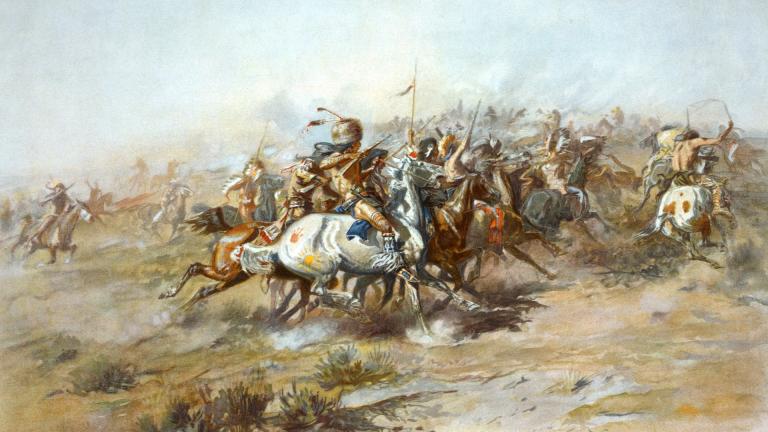
Read more about American History

As well as being one of the weirdest named battles in history, the Battle of Little Bighorn is also undoubtedly the most famous battle in the Great Sioux War. It was also the most important, given its outcome and aftermath.
On 25th June 1876, the Hunkpapa chief Sitting Bull led his people to a glorious victory over the US government forces under the command of Colonel George Custer. Custer and over 200 of his men were slaughtered in a frantic bloodbath that lasted just over two hours.
To learn more about the causes, events and impacts of Little Bighorn, read on. To find out more about the fascinating life of Sitting Bull, who became a figurehead for the Native American resistance movement, don’t miss Sky HISTORY’s brand-new Sitting Bull documentary, coming soon.
Tensions between the indigenous Native American tribes of the region and the encroaching white settlers, backed by the US government, had been growing for years.
The 1868 Treaty of Fort Laramie attempted to establish an uneasy peace by granting the lands of the Black Hills of Dakota west of the Missouri River to the tribes. However, many chiefs (including Sitting Bull and Crazy Horse) did not consent to being confined to reservations, nor to giving up their nomadic lifestyles. They did not sign the Treaty.
In the event, Colonel Custer’s discovery of gold in the Black Hills in 1874 rendered the Treaty useless, since it was not respected by the government. An influx of prospectors coming into the area – despite it legally belonging to the Native Americans – was not checked by the authorities, who tried to buy it instead. When their offers were refused, they took a harder line.
A deadline for withdrawing into designated reservations was issued. However, it’s unlikely that most of those it was aimed at were actually reachable, given their peripatetic habits. Regardless of whether they knew about this ultimatum or not, the reaction was almost non-existent. The deadline passed and the stage for war was set.
President Ulysses S Grant decided to authorise the use of blunt force against the Native population, dispatching three units to tackle the problem. These were led by General George Crook, Colonel John Gibbon and General Alfred Terry, with Custer’s regiment making up the bulk of the latter’s fighting force.
Crook was repulsed at the Battle of Rosebud, effectively ending his involvement. Custer’s 7th Cavalry were sent ahead to scout the enemy’s position, with Terry and Gibbon intended to support from opposite angles. By dawn on 25th June, Custer’s scouts found Sitting Bull’s camp.
The scouts did not have a clear idea of the numbers of warriors in the camp, but they did report that their own presence had been detected. Custer assumed that the Native Americans would flee at once and, seeing a chance to claim the glory for himself, ordered an immediate attack.
He divided his troops into three units, hoping to use a pincer movement to trap the enemy. In actuality, this decision meant that the other two units, led by Captain Frederick Benteen and Major Marcus Reno, could not provide help to Custer or each other when the plan came unstuck.
The government had believed that the Sioux, Cheyenne and Arapaho warriors would number less than a thousand, whereas the real figures are believed to be as much as three times this. What’s more, most of them were armed with Winchester repeating rifles, which were superior to Custer’s own arsenal.
Of course, the fact that no military troops survived to tell the tale means that all accounts come from Native American eyewitnesses. These were often given under duress after the fact, making them somewhat unreliable. As such, it’s difficult to ascertain exactly what happened.
Needless to say, there was much confusion and panic as the dirt rose up and the bullets whistled through the trees. While he is not thought to have participated in the battle personally, Sitting Bull’s command of his men proved to be all-important, while Crazy Horse’s fearsome fighting abilities also counted in their favour.
When all was said and done, some 215 of the 7th Cavalry were found dead, many of them at Calhoun Hill, which is now believed to be the site of ‘Custer’s Last Stand’. When Gibbon and Terry finally did arrive, the Sioux retreated.
Although the battle was a huge victory for Sitting Bull and his people, it would spark reactions that would have an outsized impact on American history and ultimately spell the end of the Sioux way of life.
The US government and public were outraged by the events, which were portrayed in the media as a barbarous attack on the army rather than armed resistance against encroachment on Native American rights. As such, the full weight of the military came down on the indigenous people.
There were several more clashes between the two sides, none of which were won by the Sioux and their allies. Crazy Horse was forced into surrender within a year, while Sitting Bull would seek exile in Canada not long after.
The Battle of Little Bighorn is commemorated by a monument at the site of Custer’s Land Stand. In 1991, after a long legal wrangle, it was renamed ‘Little Bighorn Battlefield National Monument’ instead of ‘Custer Battlefield National Monument’.
Want to explore more Native American history before the release of Sky HISTORY’s Sitting Bull documentary? Sign up to our newsletter today! Every week, you’ll receive exclusive content about some of the most fascinating stories from history delivered straight to your inbox.